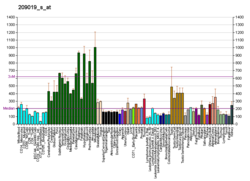| PINK1 |
|---|
|
| Identifiants |
|---|
| Aliases | PINK1, PTEN-induced putative kinase 1 |
|---|
| IDs externes | OMIM: 608309 MGI: 1916193 HomoloGene: 32672 GeneCards: PINK1 |
|---|
| Position du gène (Homme) |
|---|
 | | Chr. | Chromosome 1 humain[1] |
|---|
| | Locus | 1p36.12 | Début | 20,633,458 bp[1] |
|---|
| Fin | 20,651,511 bp[1] |
|---|
|
| Position du gène (Souris) |
|---|
 | | Chr. | Chromosome 4 (souris)[2] |
|---|
| | Locus | 4|4 D3 | Début | 138,040,720 bp[2] |
|---|
| Fin | 138,053,618 bp[2] |
|---|
|
| Expression génétique |
|---|
| Bgee | | Humain | Souris (orthologue) |
|---|
| Fortement exprimé dans | - muscle gastrocnémien
- cortex préfrontal
- amygdale
- putamen
- noyau accumbens
- Brodmann area 9
- gyrus cingulaire
- muscle triceps brachial
- noyau caudé
- internal globus pallidus
|
| | Fortement exprimé dans | - myocardium of ventricle
- muscle intercostal
- nerf ischiatique
- muscle digastrique
- muscle triceps brachial
- cheville
- muscle sterno-cléido-mastoïdien
- Muscle temporal
- Muscle oculomoteur
- septum interventriculaire
|
| | Plus de données d'expression de référence |
|
|---|
| BioGPS | 
 | | Plus de données d'expression de référence |
|
|---|
|
|
| Orthologues |
|---|
| Espèces | Homme | Souris |
|---|
| Entrez | | |
|---|
| Ensembl | | |
|---|
| UniProt | | |
|---|
| RefSeq (mRNA) | | |
|---|
| RefSeq (protéine) | | |
|---|
| Localisation (UCSC) | Chr 1: 20.63 – 20.65 Mb | Chr 4: 138.04 – 138.05 Mb |
|---|
| Publication PubMed | [3] | [4] |
|---|
|
| Wikidata |
| Voir/Editer Humain | Voir/Editer Souris |
|
PINK1 (pour « PTEN-induced putative kinase 1 ») est une kinase mitrochondriale dont le gène est le PINK1 situé sur le chromosome 1 humain.
Rôles
Il joue un rôle important dans l'homéostasie des mitochondries[5] en intervenant dans l'autophagie de ces dernières[6]. Il intervient également dans l'intégrité de la chaîne de transport d'électrons[7]. Il intervient ainsi dans plusieurs tissus, dont les neurones mais aussi le muscle cardiaque[8] et le poumon, protégeant ce dernier de la fibrose pulmonaire[9].
En médecine
La mutation du PINK1 est responsable d'une forme précoce et familiale de maladie de Parkinson[10], appelée « maladie de Parkinson de type 6 » ou PARK6. La forme inactive du PINK1 entraîne une altération des mitochondries des neurones dopaminergiques et une concentration augmentée en dérivés réactifs de l'oxygène[11] qui est délétère pour la cellule.
Notes et références
- ↑ a b et c GRCh38: Ensembl release 89: ENSG00000158828 - Ensembl, May 2017
- ↑ a b et c GRCm38: Ensembl release 89: ENSMUSG00000028756 - Ensembl, May 2017
- ↑ « Publications PubMed pour l'Homme », sur National Center for Biotechnology Information, U.S. National Library of Medicine
- ↑ « Publications PubMed pour la Souris », sur National Center for Biotechnology Information, U.S. National Library of Medicine
- ↑ (en) Chu CT, « A pivotal role for PINK1 and autophagy in mitochondrial quality control: implications for Parkinson disease » Hum Mol Genet. 2010;19:R28–37
- ↑ (en) Narendra D, Walker JE, Youle R, « Mitochondrial quality control mediated by PINK1 and Parkin: links to parkinsonism » Cold Spring Harb Perspect Biol. 2012;4:a011338
- ↑ (en) Liu W, Acin-Perez R, Geghman KD, Manfredi G, Lu B, Li C, « Pink1 regulates the oxidative phosphorylation machinery via mitochondrial fission » Proc Natl Acad Sci U S A. 2011;108:12920–12924
- ↑ (en) Billia F, Hauck L, Konecny F, Rao V, Shen J, Mak TW, « PTEN-inducible kinase 1 (PINK1)/Park6 is indispensable for normal heart function » Proc Natl Acad Sci U S A. 2011;108:9572–9577.
- ↑ (en) Bueno M, Lai YC, Romero Y. et al. « PINK1 deficiency impairs mitochondrial homeostasis and promotes lung fibrosis » J Clin Invest. 2014
- ↑ (en) Valente EM, Abou-Sleiman PM, Caputo V. et al. « Hereditary early-onset Parkinson’s disease caused by mutations in PINK1 » Science 2004;304:1158–1160
- ↑ (en) Wang HL, Chou AH, Wu AS. et al. « PARK6 PINK1 mutants are defective in maintaining mitochondrial membrane potential and inhibiting ROS formation of substantia nigra dopaminergic neurons » Biochim Biophys Acta. 2011;1812:674–684
 Portail de la médecine
Portail de la médecine  Portail de la biologie cellulaire et moléculaire
Portail de la biologie cellulaire et moléculaire
 Portail de la médecine
Portail de la médecine  Portail de la biologie cellulaire et moléculaire
Portail de la biologie cellulaire et moléculaire 



















